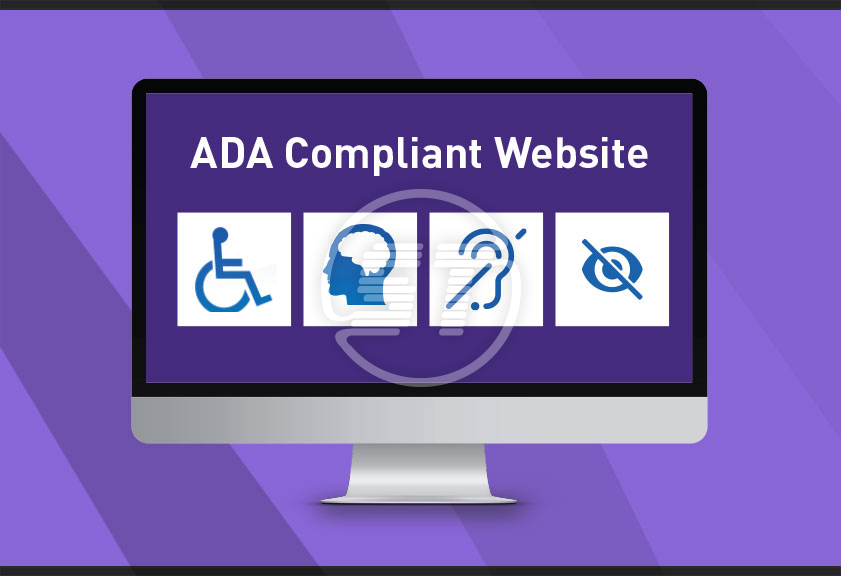The basic goal of every website owner is to welcome as many visitors as possible without any accessibility issues or design errors. However, modern-day websites are designed keeping the basic user groups in mind but not all. Besides the common user groups, many others look for a fully accessible website to consume the vital information and resources on these websites.
While the design and development are crucial for a website to appeal to the users as well as function properly, accessibility is the key to make the website accessible to all user groups. It is not difficult to make website ADA compliant in this technology-driven era.
What is Web Accessibility?
Internet is for all and all the available content on the internet must be accessible to all users with access to the internet. That's the basic principle behind the whole concept of the internet and the World Wide Web.
However, there are some user groups with disabilities, special needs or impairments which don’t allow millions of internet users to access the internet and all the websites available for public out there.
Optimizing the design and content elements to make website ADA compliant allows these users to access the website entirely without compromising because of their condition.
While there are many assistive technologies such as screen readers, speech recognition software, Braille terminals, and alternative keyboards to cater to special needs; they are not much effective if your website is not ADA compliant. In this article, we will help you understand and guide you on how to make your website ADA compliant.
Effective Ways to Make Your Website ADA Compliant
As such, almost anybody can browse the web. What's more, you can make their experiences significantly better by designing your site with accessibility in mind.
You can go through the following the ADA website compliance checklist and learn how to make a website ADA compliant effectively.
Make Sure Your Site Is Keyboard-Friendly
Mouse on our computers has made navigation easy and subtle. However, it is important that the website can be operated without using a mouse to qualify as fully accessible. With a mouse, the content accessibility becomes easy as the user can simply hover the mouse to the desired location or navigate the entire website freely pointing the arrow in any direction.
Well, most of the assistive technologies out there aren't mouse compliant and only work on keyboard-only navigation. Hence, the website must allow access to each page, all content and every link on it using just the keyboard. Most websites allow users to navigate through the different pages on the website using the “Tab” key.
The “Tab” key also allows the user to jump between links, buttons, form fields, etc. The simplest way to test whether your website works on keyboard-only mode, you can simply use the website without a mouse for a while. If there are certain elements or areas of the website which are inaccessible, then your website is surely not ADA compliant yet.
Make Sure All Content Is Easily Accessible
This is the era of dynamic content and most websites rely on Content Management Systems to power their websites with dynamic content for better control and easy management. Take news portals or sports websites for example. Most sections on these websites are dynamic which makes it difficult for the screen readers to access the website accurately.
Screen readers read the website as it appears at the first load. Any dynamic content that changes afterward isn't updated and the user will miss the new content or update altogether.
Well, this key issue can be sorted by assigning tags to dynamic content areas with the help of ARIA landmarks. Such tagging will help the screen readers and other similar assistive technologies to realize the content updates and hence become more helpful to the users.
ARIA also helps to structure the website in such a way that it allows the users to easily skip to the main content. ARIA can be helpful in many ways to make your website ADA compliant if put to good use.
Make the images readable
As surprising as it may sound, this is one of the most important and crucial steps to help you make an ADA compliant website. Adding an alt-tag to an image turns the image into a readable image.
While the alt-tags are more prominently used as an SEO factor, the effect is much larger when you consider the accessibility factor. The text used as the alt-tag works as an alternative for the image itself whenever the image fails to load for the user. Most webmasters use relevant keywords within the alt-tag to improve the searchability factor as well. Using relevant keywords in the alt-tag provides relevant information to the search engine crawlers as these bots are incapable of reading the image visually and help improve the site’s SEO efforts in the process.
Wise choice of colors
Colors are a vital part of website design as it offers the right appeal and emotions to the website. Red for power, Blue for openness, Green for growth, and Orange for warmth are some colors widely used on popular websites. Irrespective of how vibrant or effective these colors are in their relative spectrum, there's much more to the colors when it comes to total website accessibility.
Mixing the colors well is equally important as it allows the users to distinguish between different elements within the website without causing any kind of stress on the eyes. The background of the website must be in direct contrast with the text color throughout the website including Headings, Links, etc.
Using the right headers for proper content structure
Most web design professionals focus on visual appeal while designing a web page. However, there's much more to a web page design than the visual element. For instance, the website structure is crucial to make your website ADA compliant and accessible to all users.
Using the right structure with proper headers helps the reader consume the content effectively without losing the focus. Clear headers also help the screen readers explain the content on each page better. Implementing the right hierarchy for the heading tags is the most ignored element of website design by modern-day designers.
A webpage must only contain one H1 tag. The following heading tags such as H2, H3, and H4 must follow in the right order nesting the content into proper sections. Using the H4 tag directly after an H2 tag must be avoided. The flow of using heading tags in the right order is important for the search engines and assistive technologies such as screen readers to understand and interpret the content on the web pages better.
Forms are crucial nowadays
If “Content is King” in the internet world, the forms on a web page are loyal Knights as they are the source of extracting data from the users. Whether it’s a contact form for inquiries or a newsletter sign up opt-in, these forms need equal attention as the other elements on a web page. Each field on the form must be correctly labeled for the users, especially the ones using a screen reader to access the website.
Labels must be aligned adjacent to the respectively so the users can match the corresponding field effectively irrespective of whether they are using a screen-reader or not.
Avoid using tables and keep it simple to display content
Using tables for anything other tabular data will make the website more complex instead of simplifying the content delivery. Accessing data in a table format is easy to understand for most but not for all, especially the ones using assistive technology to access the website.
It is important to avoid using tables to display list items, layouts, or anything except the tabular data. Use simple plain text to display contents such as list items to offer better reader accessibility to all users.
Ensure that resizing is enable on the website
Resizing text on a web page allows the reader to consume the content better. The resizing feature allows the user to enlarge the font size to an optimum level to read the content. Most browsers and devices offer resizing feature, but it is equally important for your website to support such feature to make it work effectively.
If the website design isn’t optimized for resizing, the design of the website will easily break whenever someone tries to resize the text. That’s not a user-friendly feature and makes your website less ADA compliant.
In addition to enabling the resize feature on the website, you should also keep the user scalability active all the time to allow the users to resize text when they need it. It is important to use relative sizes for text fonts instead of absolute units to avoid such hassle in the future. Relative sizes will allow the text to scale according to the screen size of the device used to access the website.
Automatic media plays and navigation must be avoided
There are many websites on the internet today which feature automatic media plays as soon as the website loads. It is not only annoying for the users but also makes it difficult in terms of accessibility.
It is near to impossible for the users accessing the website using screen readers to find and stop the media play. Also, it may annoy, frighten, or confuse users because of the sudden noise as it is not very common for websites to automatically start playing music or audio files as soon as the website loads.
In addition to automatic media plays, it is also important to put a stop on auto-play carousels or sliders. Offering the control of moving the slides or carousels to the users will allow the user to take the maximum time to consume the content before navigating to the next section.
Make the content more precise and easier to understand
Well, optimizing the design elements to better user accessibility is only effective when the similar considerations are also put in while creating content on the website. Posting content on the website is for the readers and there’s no way to identify or calculate the user type accessing the website content at that very moment.
Hence, the content on your website must be precise and quite simple to understand. Explaining the acronyms in full using brackets and adding the right anchor text to describe the links will help the readers understand and trust the content better.
Over to You!
Website accessibility is an important factor but also the most ignored one. Offering a website that is accessible to all fulfills the real mission behind the invention of the internet which is to connect the world. With some simple methods, you can easily fulfill the ADA requirements for websites and improve ADA website accessibility. Just follow the tips mentioned above and make website ADA compliant to attract more traffic and conversions.
Skynet Technologies USA LLC is a Las Vegas based company offering visually excellent and user-friendly ADA compliant website design to make the website accessible for people with cognitive and physical disabilities. Whether you are a start-up, businesses, enterprise, corporation or web development agency, hire our dedicated developer today on hourly, monthly and fixed cost basis or Partner with us for your ADA compliant website development projects.
Skynet Technologies’ auto-remediation technology based All In One Accessibility widget has an array of features that address regular accessibility concerns. Surprisingly, it just takes a single line of code to make your website compliant with WCAG 2.1 AA level. Get a free version or purchase a pro version.


